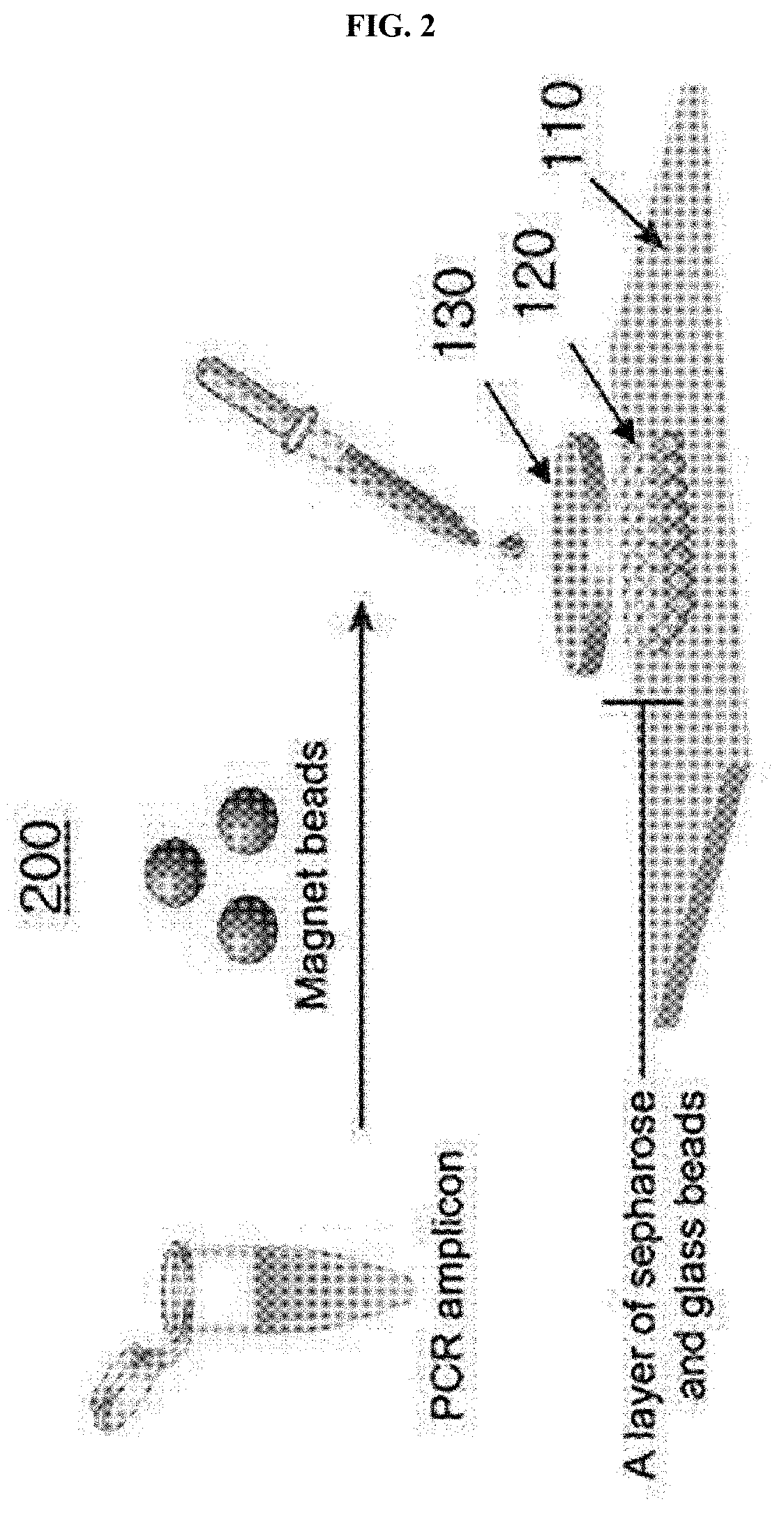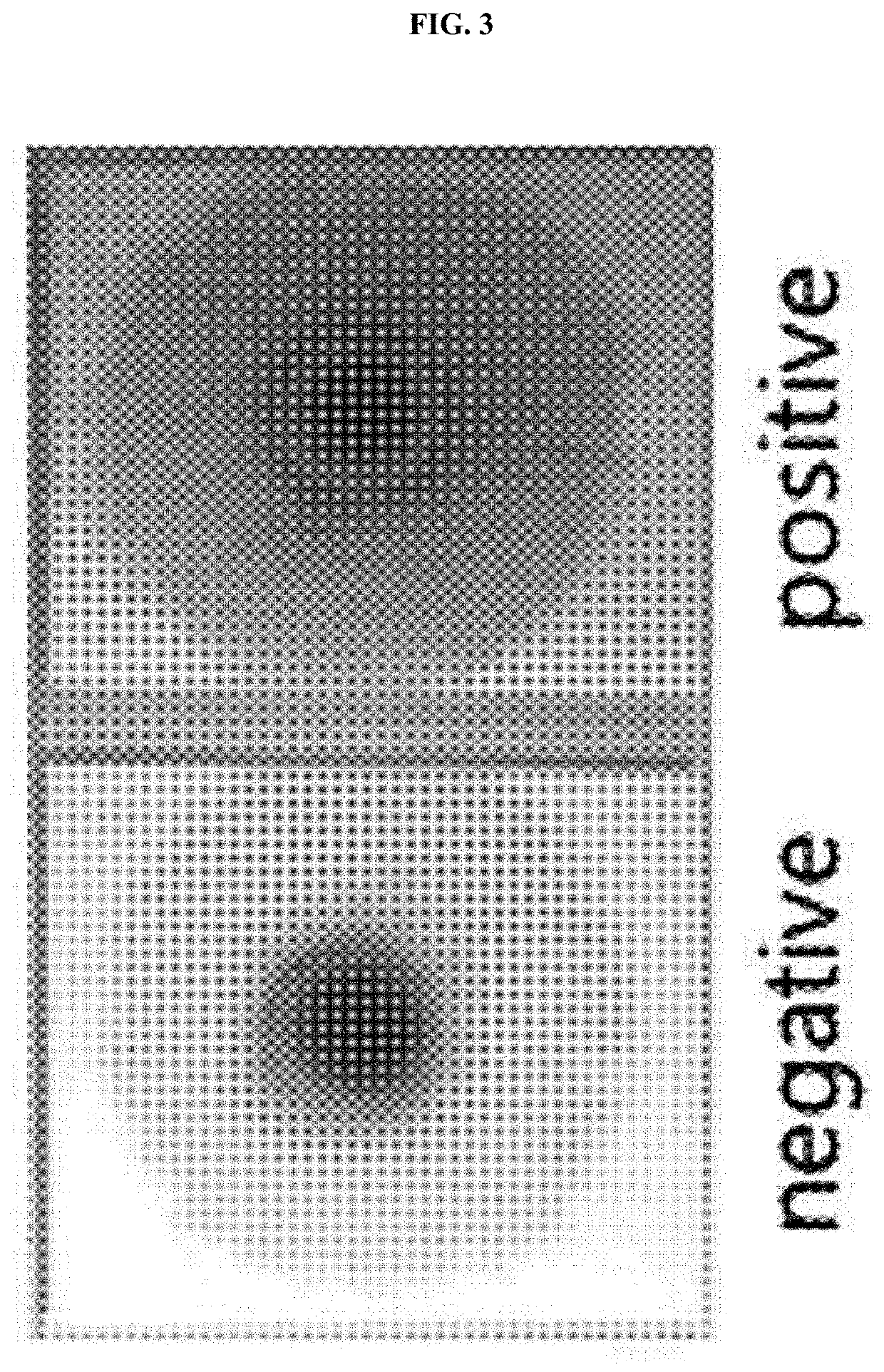Paper-based, nucleic acid-detecting kit and method for analysis of PCR amplicon
a nucleic acid and kit technology, applied in biochemistry apparatus and processes, laboratory glassware, biochemical apparatus and processes, etc., can solve the problems of complex manufacturing processes, high operator requirements, and limited use of pcr devices, so as to facilitate and simply detect the presence of target nucleic acids easy and simple detection
- Summary
- Abstract
- Description
- Claims
- Application Information
AI Technical Summary
Benefits of technology
Problems solved by technology
Method used
Image
Examples
example 1
Preparation of PCR Amplicon
[0086]1) Preparation of Sample
[0087]As an example, the reproducibility and accuracy of the present invention was intended to be confirmed by detecting DNA in an HPV subject using a paper-based DNA diagnostic kit of the present invention. A sample to be used with the paper-based DNA diagnostic kit of the present invention is not particularly limited as long as the sample is a biotin-labeled amplicon obtained by general PCR amplification, and the sample in the present invention was prepared as follows.
[0088]When genomic DNA was extracted from a cervical specimen to be tested, a nucleic acid was extracted according to the manufacturer's instructions using a nucleic acid extraction kit (QIAamp DNA Micro kit, QIAGEN, Valencia, Calif., USA or ChargeSwitch gDNA 1 μl Serum Kit, Life Technologies, N.Y., USA), and 24 HPV16 DNA positive samples and 6 positive samples of different HPV types were prepared for repeated experiments by requesting a human papillomavirus (H...
example 2
Confirmation of Analysis Results of Amplicon using Paper-Based, Nucleic Acid-Detecting Kit
[0092]1) Paper-Based, Nucleic Acid-Detecting Kit
[0093]A first solution (magnetic beads suspension) in which streptavidin-coated magnetic beads were dispersed (10 mg / ml Dynabead My One Streptavidin C1, Life Technologies, Grand Island, N.Y., USA) was prepared.
[0094]Further, a first paper substrate was prepared using Fusion 5 paper (GE Healthcare, Pittsburgh, Pa., USA) with a size of 6×6 cm. A separation layer was formed by applying 24 μl of a Sepharose solution (a low ionic strength solution (LISS) buffer in which 2 mg / μl was dispersed) and 8 μl of 75 mm glass beads (1:1 v / v with LISS and 0.1% Triton-X) with a surface (circular shape) of 6×6 mm onto the first paper base, and drying the first paper substrate at room temperature. Next, a second paper substrate was manufactured by stacking Fusion 5 paper(GE Healthcare, Pittsburgh, Pa., USA) with a size of 6×6 mm in a circular shape on the separation...
example 3
Confirmation of Analysis Results of Amplicon using Paper-Based, Nucleic Acid-Detecting Kit
[0105]1) Paper-Based, Nucleic Acid-Detecting Kit
[0106]A first solution (magnetic beads suspension) in which streptavidin-coated magnetic beads were dispersed (10 mg / ml Dynabead My One Streptavidin C1, Life Technologies, Grand Island, N.Y., USA) was prepared.
[0107]Further, a first paper substrate was prepared using Fusion 5 paper (GE Healthcare, Pittsburgh, Pa., USA) with a size of 6×6 cm. A separation layer was formed by applying 24 μl of a Sepharose solution (a low ionic strength solution (LISS) buffer in which 2 mg / μl was dispersed) and 8 μl of 75 mm glass beads (1:1 v / v with LISS and 0.1% Triton-X) with a surface (circular shape) of 6×6 mm onto the first paper base, and drying the first paper substrate at room temperature. Next, a second paper substrate was manufactured by stacking Fusion 5 paper(GE Healthcare, Pittsburgh, Pa., USA) with a size of 6×6 mm in a circular shape on the separation...
PUM
| Property | Measurement | Unit |
|---|---|---|
| size | aaaaa | aaaaa |
| thickness | aaaaa | aaaaa |
| size | aaaaa | aaaaa |
Abstract
Description
Claims
Application Information
 Login to view more
Login to view more - R&D Engineer
- R&D Manager
- IP Professional
- Industry Leading Data Capabilities
- Powerful AI technology
- Patent DNA Extraction
Browse by: Latest US Patents, China's latest patents, Technical Efficacy Thesaurus, Application Domain, Technology Topic.
© 2024 PatSnap. All rights reserved.Legal|Privacy policy|Modern Slavery Act Transparency Statement|Sitemap



